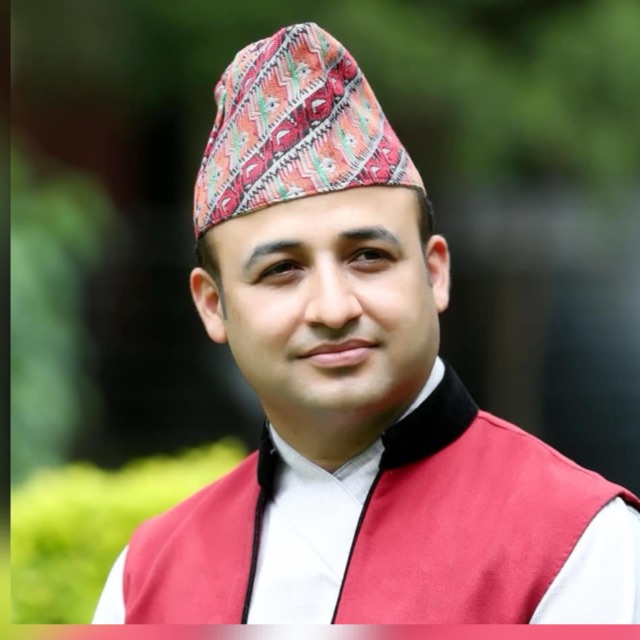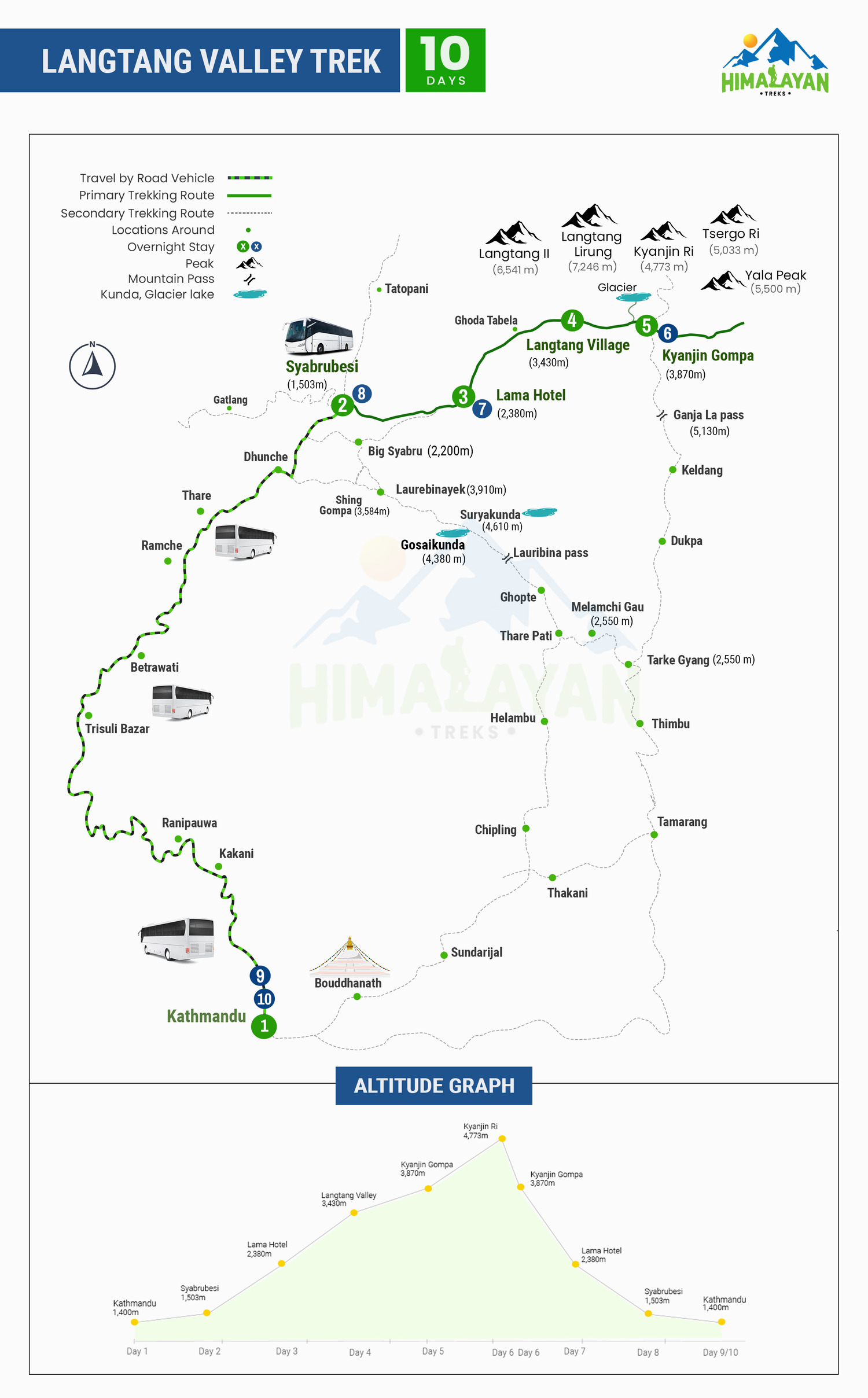Langtang Valley Trek- 10 Days
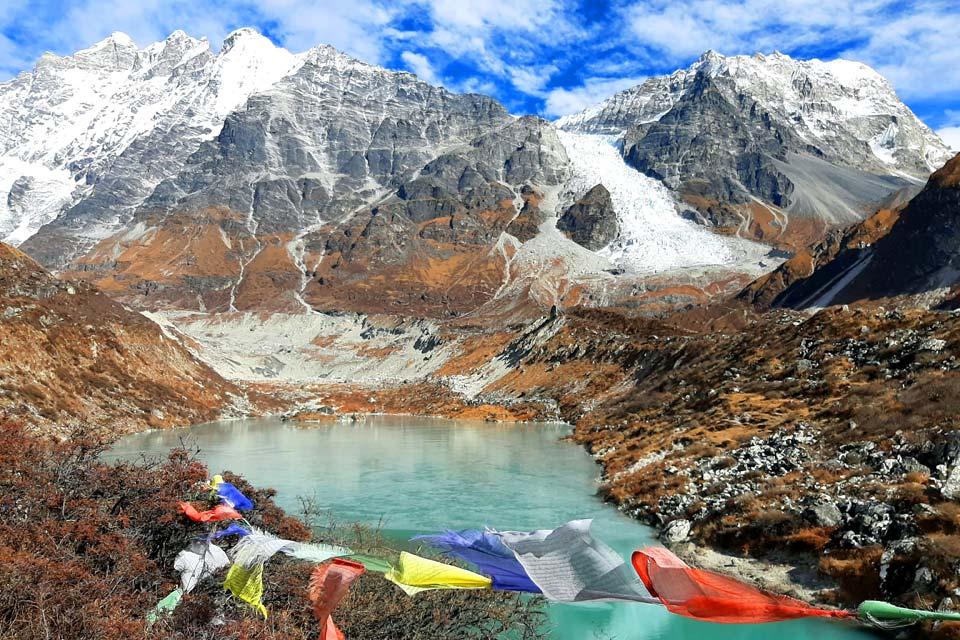
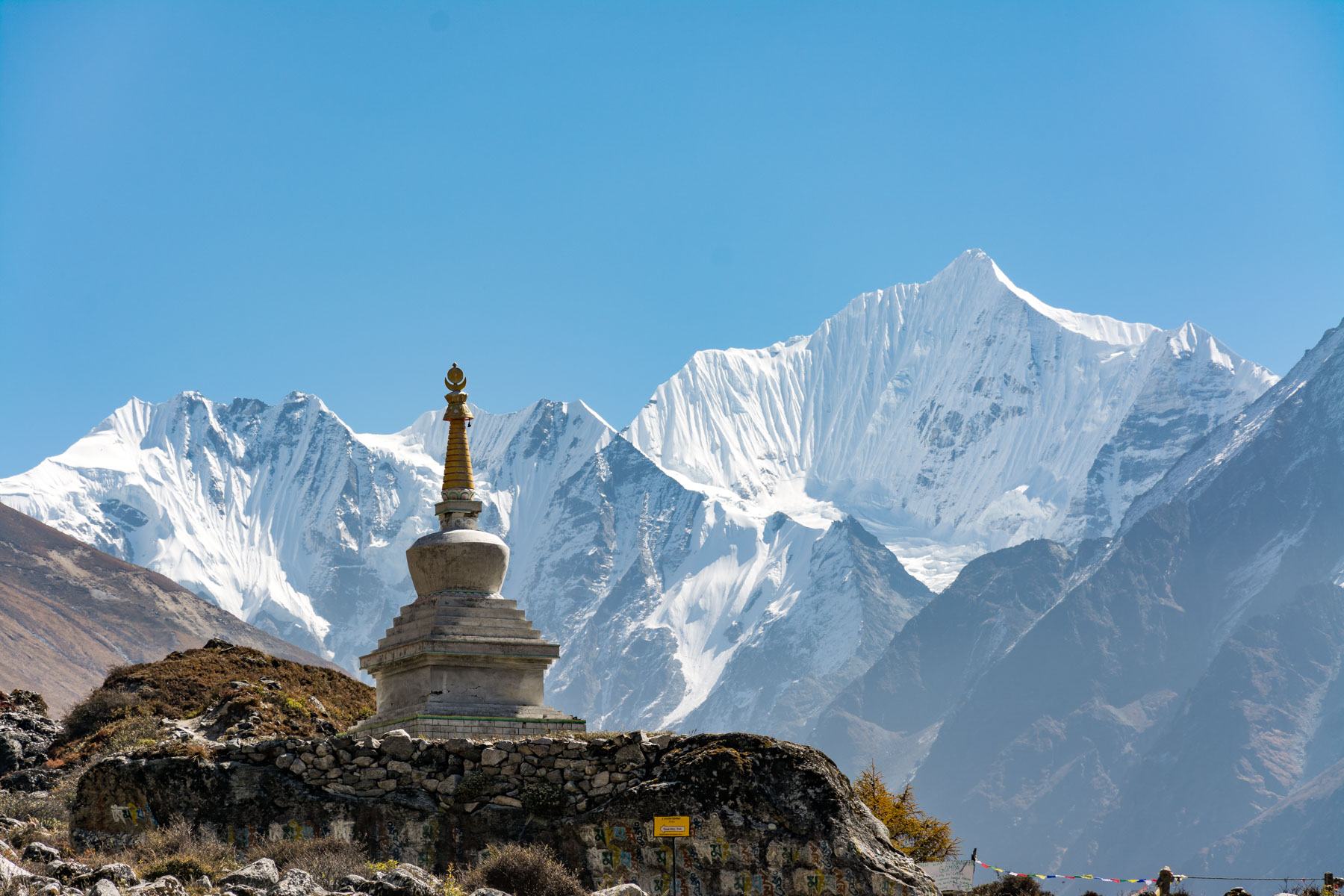
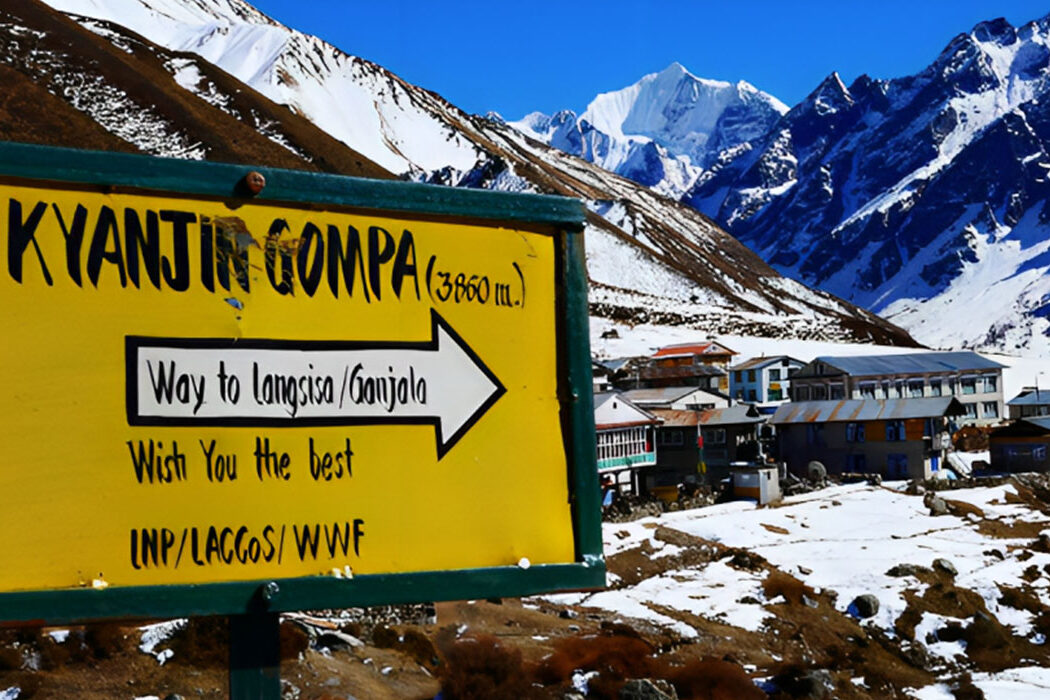
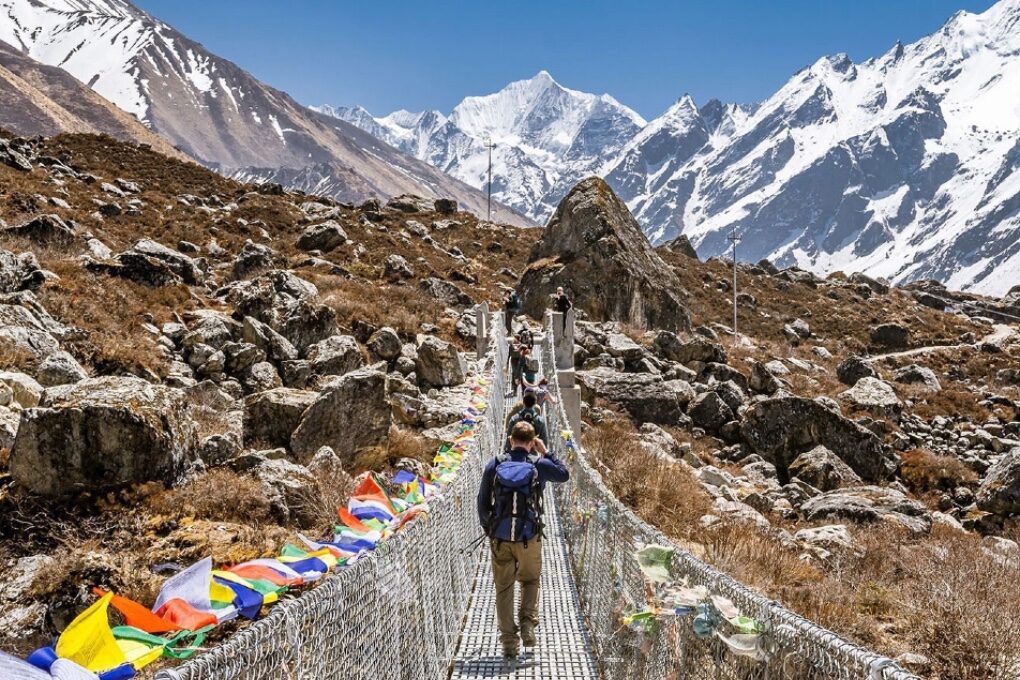
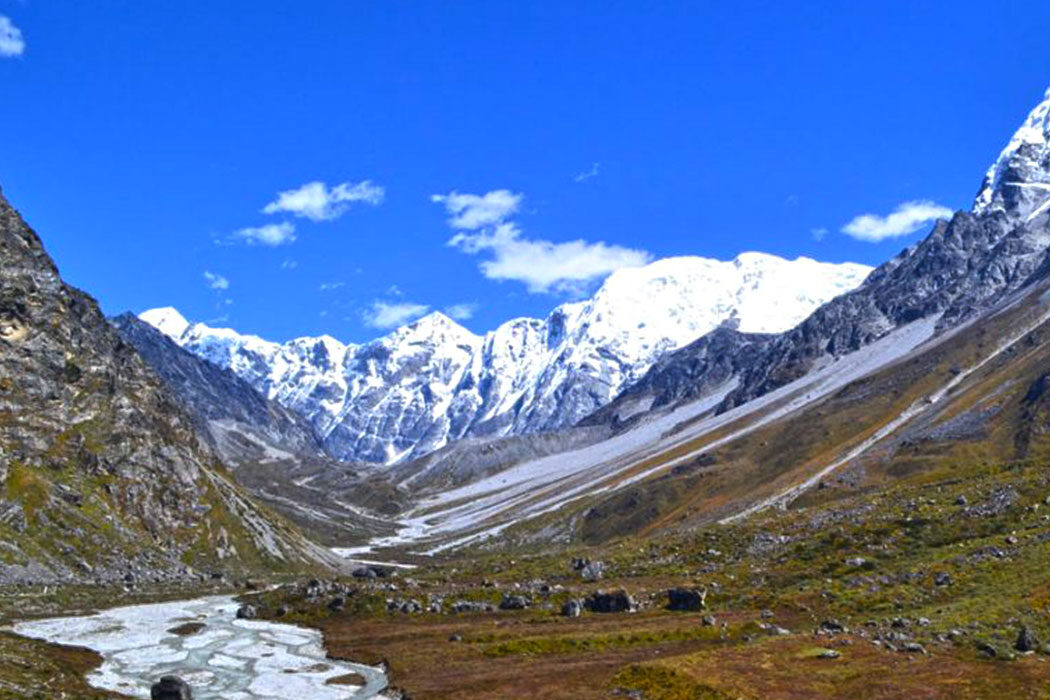
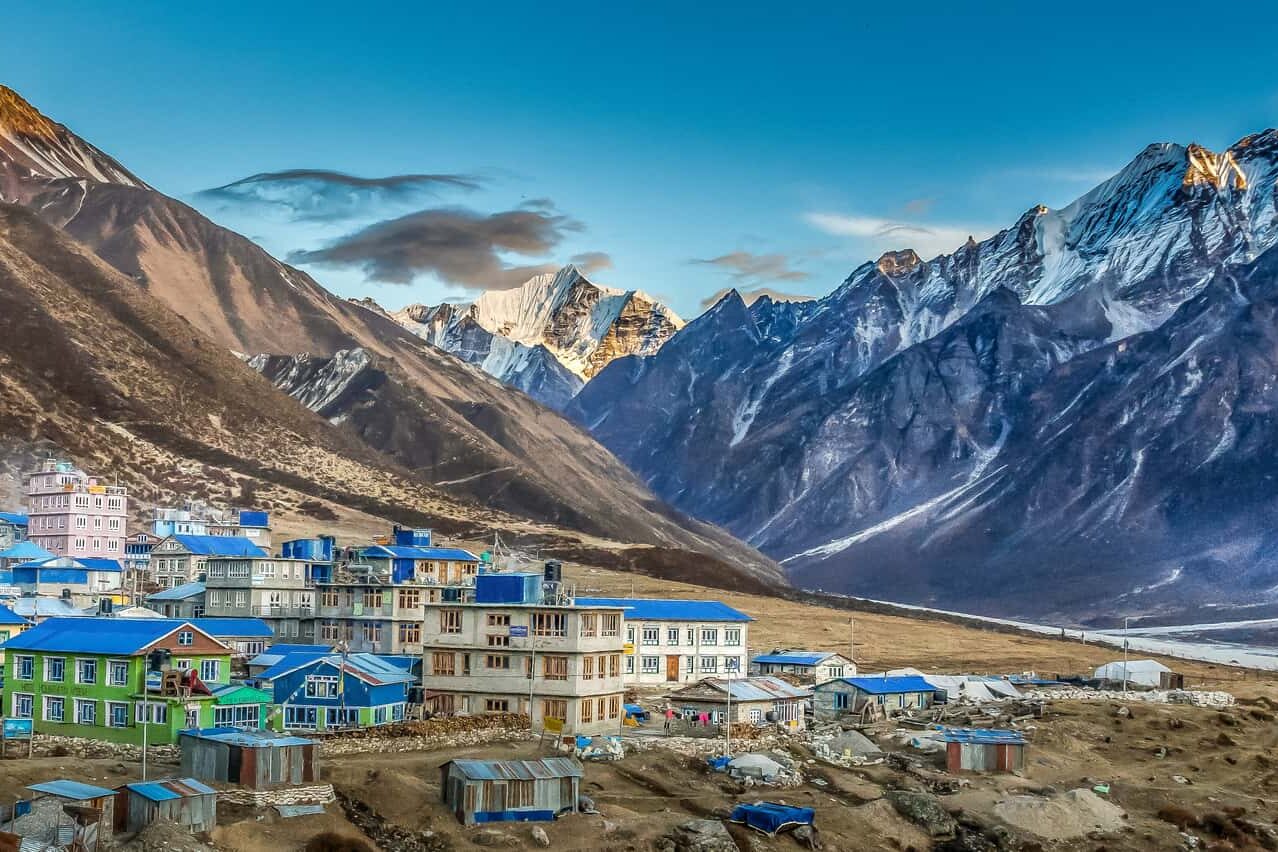
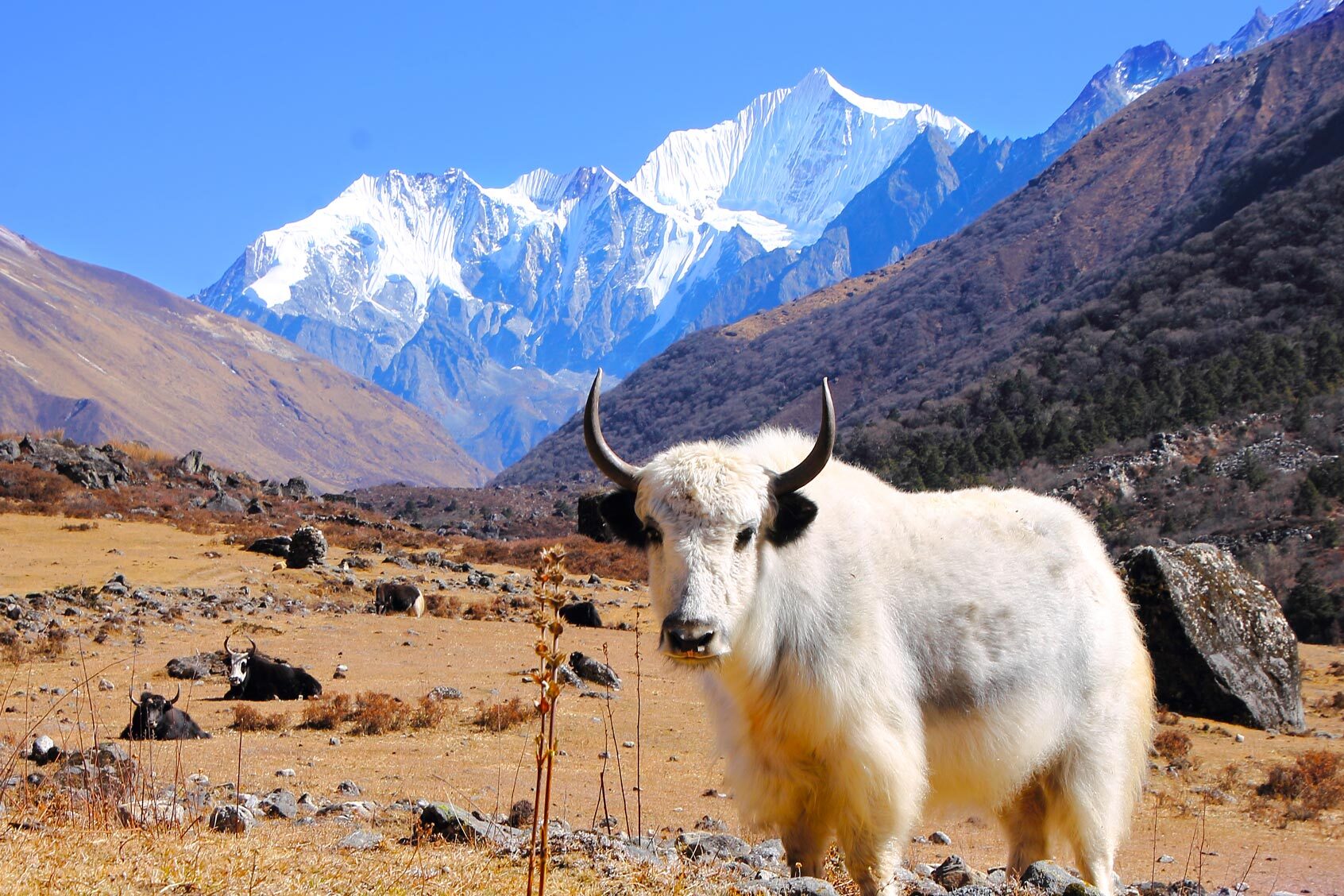
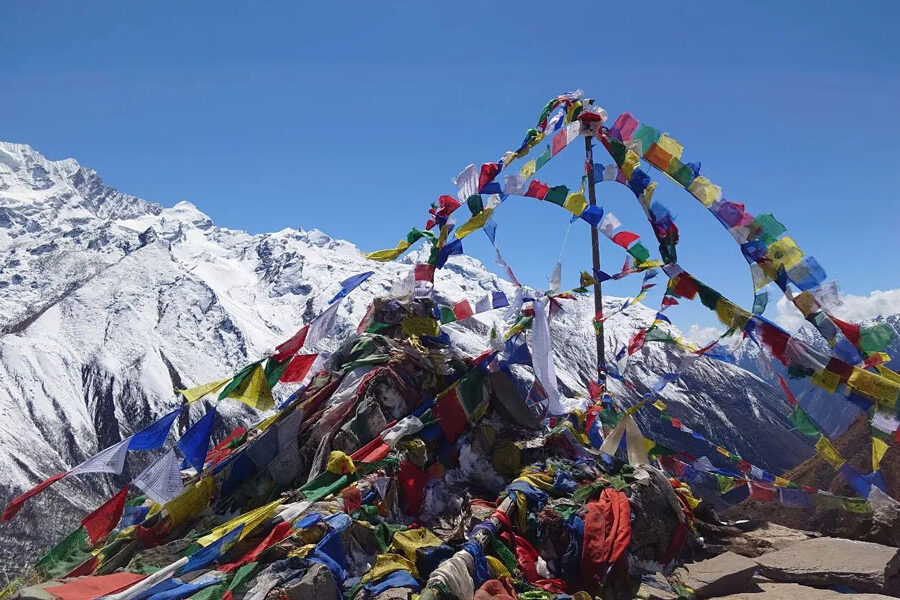
Good To Know
-
Country Nepal
-
Duration 10
-
Destination Langtang Region
-
Routes Kathmandu- Syabrubesi- Kyanjin Ri
-
Max. Altitude 4773m
-
Activity Trekking
-
Meals Includes Lunch, Dinner, Breakfast (*)
-
Accommodation Hotels/ Teahouses
-
Best Season Feb- May/ Sept-Nov
-
Difficulty Moderate
-
Start / End trip Kathmandu
Trip Introduction
Langtang Valley Trek, nestled deep within the Himalayas, is a testament to natural wonder and cultural richness. Explorers who venture into this pristine corner of the world are met with various landscapes, cultures, and hospitality that captivate the senses.
Here, diverse flora and fauna flourish, with lush forests of rhododendron, oak, and pine trees adorning the hillsides. Towering peaks such as Langtang Lirung, Langtang II, and Ganchempo dominate the skyline, casting awe-inspiring shadows across the land.
The cultural tapestry of Langtang Valley is woven with threads of Tibetan Buddhism, evident in the monasteries, chortens, and prayer flags that adorn the landscape. Locals of Tibetan descent lead simple lives yet deeply connected to nature and spirituality.
When it’s time to refuel, Langtang Valley offers a tempting array of Tibetan and Nepalese cuisine. From hearty dal bhat to steamed momos and comforting thukpa, there’s no shortage of delicious treats to energize adventurers on the trails. And don’t miss out on sampling yak cheese and butter tea to taste local specialties.
Despite its natural beauty, Langtang Valley’s population remains small, with scattered Sherpa, Tamang, and Tibetan communities. These resilient communities rely on farming, animal husbandry, and a touch of tourism to sustain their way of life.
A real highlight is the Langtang Trek, which takes treks through dense forests, adorable villages, and challenging mountain passes. Many people come from all over the world to experience the beauty and genuineness of Himalayan life for themselves.
The Langtang Trek continues to draw adventurers looking for once-in-a-lifetime adventures because of its beautiful mountains, lively culture, and friendly people. Whether you’re chasing thrills, seeking spiritual solace, or simply enjoying the camaraderie of the trail, the trek to Langtang Valley promises an adventure that leaves a lasting impression.
Short Langtang Valley Trek Itinerary:
Day 01: Arrival at Kathmandu Airport and Transfer to Hotel.
Day 02: Drive from Kathmandu to Syabrubesi.
Day 03: Trek from Syabrubesi to Lama Hotel.
Day 04: Trek from Lama Hotel to Langtang Village.
Day 05: Trek from Langtang Village to Kyanjin Gompa.
Day 06: Explore at Kyanjin Ri.
Day 07: Trek from Kyanjin Gompa to Lama Hotel.
Day 08: Trek from Lama Hotel to Syabrubesi.
Day 09: Drive from Syabrubesi to Kathmandu.
Day 10: End of the journey to the airport.
HIGHLIGHTS OF LANGTANG VALLEY TREK
Exquisite Mountain Landscape
Hiking in the Langtang Valley provides awe-inspiring vistas of majestic summits like Langtang Lirung, Langtang II, and Ganchempo. The view of these snow-capped mountains set against the backdrop of the Himalayan environment is quite breathtaking.
Deep Cultural Encounter
The trip leads you through authentic villages populated by Sherpa, Tamang, and Tibetan communities. You will encounter Buddhist monasteries, prayer flags, and shortens during your journey, deeply engaging you with the local culture and spirituality.
Scenic Landscapes
The Langtang Valley showcases breathtaking scenery, from dense forests of rhododendron, oak, and pine trees to high-altitude meadows and glacial moraines.
Wildlife Encounters
The critically endangered red panda, the Himalayan black bear, and a wide variety of bird species are just a few of the many animals that live there. While traversing their native environment, remain vigilant for these elusive species.
Serene Lakes
The Serene Lakes journey allows you to explore exquisite alpine lakes like Gosainkunda and Kyanjin Gompa. These lakes offer serene environments and breathtaking mountain reflections.
Generous Welcome
During the journey, you will receive a warm and hospitable greeting from the villagers, renowned for their generosity and friendliness. Indulge in genuine Nepalese gastronomy and experience the genuine warmth of mountain hospitality.
Kyanjin Ri Summit
The Kyanjin Ri Summit is a notable feature of the climb. It provides a vantage point that offers extensive views of the Langtang Valley and the other peaks. The arduous trek offers stunning panoramas that will astonish you.
Cultural Exploration
Explore traditional villages and interact with local inhabitants to deeply understand their lifestyle, practices, and heritage. Participate in cultural events and ceremonies to enhance your comprehension of indigenous culture.
Spiritual Retreat
Due to its serene surroundings, a spiritual retreat in the Langtang Valley offers an ideal environment for contemplation and mindfulness. Allocate a portion of your schedule to connect with the natural world and revitalize your mental, physical, and spiritual well-being within the tranquil setting of the Himalayan terrain.
Feeling of Accomplishment
Successfully finishing the Langtang Valley Trek is a notable achievement that instills trekkers with a feeling of satisfaction and contentment. Whether it involves scaling formidable mountain passes or surmounting personal obstacles, the expedition makes an indelible impact and creates enduring memories to be cherished throughout one’s lifetime.
BEST SEASON FOR LANGTANG VALLEY TREK
Trekkers often regard autumn (September to November) and spring (March to May) as the optimal times for the Langtang Valley trip. Clear and stable weather typically provides excellent visibility and suitable trekking conditions during these seasons.
During the fall season, the atmosphere is frequently characterized by exceptionally clear skies, which offer stunning vistas of the majestic Himalayan summits. Additionally, the temperatures are moderate during this time, creating a pleasant environment for trekking activities. During the spring season, the temperatures rise, and the rhododendron forests start to bloom, enhancing the visual appeal of the trek.
These seasons are optimal as they align with the arid periods in Nepal, reducing the likelihood of precipitation and guaranteeing well-maintained routes. In addition, the lively ambiance throughout autumn and the colorful spring vegetation enhance the trekking experience.
Although trekking during the monsoon season (June to August) is feasible, there is an increased likelihood of encountering rain, landslides, and leeches along the routes. Similarly, during the winter (December to February), low temperatures and the potential for snowfall can increase trekking difficulty, particularly at higher elevations.
In general, fall and spring are commonly considered to be the most favorable seasons for embarking on the Langtang Valley trek. During these times, the weather conditions are ideal, and the landscape is stunning, making for a remarkable Himalayan expedition.
No. of Pax |
Cost (per person) |
1 Pax |
$ 1100 |
2 Pax |
$ 800 |
3-5 Pax |
$ 750 |
6-10 Pax |
$ 650 |
11-16 Pax |
$ 550 |
Itinerary
Prepare to immerse yourself in the vibrant chaos of Kathmandu as soon as you step off the plane. Prepare for a sensory feast that will awaken your senses and ignite your spirit. Our dedicated team from Himalayan Adventure will be waiting for you at the airport (Tribhuvan International Airport) to ensure your smooth transition into this bustling city.
As you navigate through the bustling customs area, you’ll be enveloped in the rich aroma of incense and spices while people’s lively chatter and movement fill the air. Despite the hustle and bustle, there’s an infectious sense of excitement and energy.
Amidst the lively chaos of arrivals, your trusted guide will greet you and guide you through the maze of Kathmandu’s streets to your sanctuary in this captivating place.
The wide variety of sights, sounds, and smells that characterize Kathmandu’s distinctive charm will enthrall you as you walk through the bustling streets. From bustling markets to ancient temples, every corner tells a story of history and tradition.
Finally, you’ll arrive at your refuge: the hotel. Nestled amidst the city’s bustling energy, it offers a tranquil oasis where you can catch your breath and prepare for the adventures that lie ahead. Take a moment to adjust to the higher elevation, relax, and soak in the lively atmosphere of Kathmandu.
As the sun sets over the city, casting a warm golden glow over the ancient buildings and bustling streets below, you’ll feel a sense of awe and wonder at the beauty of this extraordinary place. Welcome to Kathmandu, where every moment is an opportunity for discovery, and every corner holds the promise of adventure.
-
Duration 30 Min
-
Altitude 1400m
-
Accommodation 3* Hotel
Get ready for the most exciting trip of your life as we head from Kathmandu to Syabrubesi! The Himalayan Treks team will pick you up from your hotel. Ready to leave the chaos of the city behind and dive right into the Nepalese countryside’s stark beauty.
As we start this epic trip, get ready for many different feelings and experiences. The road ahead has many turns and twists, but each one leads to a new adventure.
With our brave driver in charge, we’ll easily avoid rickshaws and cows as we drive through busy streets. As we leave the city behind and enter the unknown, the air is filled with excitement.
The scenery starts to change as the city gets farther away. Cute towns and terraced fields spread out across the lush green hills in front of us. The air is full of the sounds of birds singing and rivers running—a symphony of nature’s most beautiful tunes.
Do not be fooled, though; this is not a Sunday drive. Our patience and determination will be tested on the rough road ahead. But don’t worry—every bump and hole in the road is another part of our epic trip.
Our journey will go on for hours and miles, and we’ll soon be in the beautiful foothills of the Himalayas. In the distance, huge hills with snow-covered tops seem to reach for the sky.
Our final stop will be Syabrubesi, which we will reach after six or seven exciting hours on the road. This cute town in the mountains is our home away from home and the start of our adventures.
Let’s prepare for the next part of our big Himalayan journey by stretching our legs and breathing in the fresh mountain air. We are now in Syabrubesi.
-
Duration 6-7 Hrs
-
Altitude 1503m
-
Meals Lunch, Dinner, Breakfast
-
Accommodation Teahouse
Now, you bold spirits, it’s time to lace up your boots and hit the trail! Today, we begin trekking into the heart of the Langtang Valley.
We said goodbye at the end of our stay at Syabrubesi and set our sights on Lama Hotel, our next stop on this epic trip. The path goes through thick forests, where birds sing and leave rustle. Wildlife may be running through the trees, so keep your eyes open. You never know what the forest has in store for us.
The scenery starts to change as we slowly rise through the valley. As we trek, we see waterfalls and brooks whose clear, cool water reminds us of how much nature has to offer. Hiking in the Himalayas is all about stopping to enjoy the beauty of your surroundings.
After a few hours of hiking, we arrive at the Lama Hotel, our nice place to stay for the night. This cozy cabin is tucked away in the mountains and is a great place to rest and recharge after a day on the trail. So take off your boots, ease your tired muscles, and prepare to fall asleep to the sounds of the forest. Tomorrow, we’ll continue our trip deeper into the Langtang Valley.
-
Duration 5-6 Hrs
-
Altitude 2380m
-
Meals Lunch, Dinner,Breakfast
-
Accommodation Teahouse
Have an amazing day, fellow travelers! Today, We are preparing for another day of trekking in the beautiful Langtang Valley. After a hearty breakfast at the Lama Hotel, we’ll be back on the trail, ready to take on any difficulties that come our way.
The road ahead opens up like pages in an interesting book, with new amazing sights to see at every turn. After leaving the dense forest, we can see far ahead, where tall peaks and rolling fields are spread out.
Our destination for today is Langtang Village, a cute town tucked away in the rough mountains. Along the way, we will pass cute Sherpa villages. The people there will greet us with big smiles and encouraging words, making our trip feel even more like a group effort.
The scenery becomes more beautiful, and the air becomes cooler with each step. Snow-capped peaks dominating the horizon are a stunning reflection of how magnificent nature is.
We finally get to Langtang Village after a long day of hiking. It will be a nice place to stay for the night. The people here are known for their warm kindness, and we’ll be served hearty meals to keep us going. Let’s take it easy and enjoy the peace of this mountain haven. Our trip through the Langtang Valley continues tomorrow.
-
Duration 5-6 Hrs
-
Altitude 3440m
-
Meals Lunch, Dinner, Breakfast
-
Accommodation Teahouse
The next part of our Langtang Valley trekking starts today and will be exciting. After a full breakfast in Langtang Village, we’ll put on our boots and hit the trail again, ready to take on the rough terrain ahead.
The road in front of us looks like an interesting tapestry. It winds through valleys and up to the sky. As we leave it, the scenery changes from the town to a stunning view of snow-capped peaks and rocky ridges.
We’re going to Kyanjin Gompa, a holy temple high in the mountains. We’ll pass through mountain streams sparkling with waterfalls and alpine fields bursting with vibrant wildflowers. The scenery gets even more stunning as we go higher into the cool mountain air. Wide views of the surrounding peaks amaze us with their beauty.
After a difficult but gratifying day of trekking, we’ll finally reach Kyanjin Gompa, our safe place in the middle of the tall mountains. Here, the friendly people will make us feel welcome, and the views of the Himalayas will take our breath away.
Let’s relax and enjoy the peace and quiet of this mountain refuge. Tomorrow, we’ll learn more about Kyanjin Gompa and its surroundings, immersing ourselves in the Langtang Valley’s rich cultural and natural heritage.
-
Duration 5-6 Hrs
-
Altitude 3870m
-
Meals Lunch, Dinner, Breakfast
-
Accommodation Teahouse
Dear travelers, now is the time to rest your tired legs and explore the beauty of Kyanjin Gompa! We’re ready to take on this rest day with as much energy as we would have for climbing Everest after a breakfast that would make even the most experienced mountain climbers look weak.
We’ll trek around Kyanjin Gompa like explorers on a journey. With its narrow streets and old stone homes decorated with bright prayer flags, this Sherpa town looks like it came straight out of a storybook. Everyone should plan their trips before they go because every corner holds a new find, and every smile from a local reminds us how friendly people are in the Himalayas.
But wait, we’re not even close to being done! Putting on our boots and getting ready for Kyanjin Ri, the trek of a lifetime. Yes, we will attack this monster of sight with all the speed of a seasoned climber. Kyanjin Ri is 4,773 meters (15,659 feet) high and has views that will make your head spin, both because of its high and beautiful scenery. Let’s become Sherpas and take over Kyanjin Ri like the heroes we are!
And don’t worry if you’d rather take it easy—we won’t judge! It’s still fun to be here, whether you want to hang out with the yaks in the nearby field or enjoy the mountain air from our lodge.
As the sun goes down over the Himalayas, giving the land a golden glow, we’ll all get together for a feast fit for mountain kings and queens. More exciting events will come in the Langtang Valley tomorrow, so let’s raise a glass to that!
-
Duration 5-6 Hrs
-
Altitude 4773m
-
Meals Lunch, Dinner, Breakfast
-
Accommodation Teahouse
We have to leave Kyanjin Gompa and its beautiful views behind us as we start the next part of our Langtang Valley journey. After a big breakfast and one last look at the high hills, we put on our boots and hit the trail again.
As we start to go down from Kyanjin Gompa, which is at an amazing 3,870 meters (12,697 feet) above sea level, we can see views that go on forever. There are snow-covered peaks in the Langtang range that stand tall and majestic above us. Their rough sides cast dramatic shadows across the valley below.
The trail winds through a landscape that is unlike any other. Rhododendron and bamboo woods give way to lush meadows filled with bright wildflowers. The air gets warmer, and the sound of running rivers and waterfalls fills us with peace as we go down.
We stop at cute Sherpa towns along the way to see how the people there live their daily lives against the stunning Himalayas. The humbleness of their way of life makes me think of how strong people can be in the face of nature’s beauty.
When we get to lower elevations, the scenery changes. Pine and oak woods become thick and surround us in a peaceful way. There are different views, but they are all stunning. Every turn in the Langtang Valley gives you a new way to see its natural beauty.
This is the end of a long day of trekking. The Lama Hotel is in the middle of the valley’s green woods. People will greet us with warm smiles and serve us hearty meals. We’ll also be able to rest our tired bodies and get ready for the experiences that are yet to come.
Leave our boots at the door, take a seat, and enjoy the memories of yet another amazing day in the Langtang Valley. We’ll keep going back to society tomorrow, but for now, let’s enjoy the peace and quiet of this mountain paradise.
-
Duration 5-6 Hrs
-
Altitude 2380m
-
Meals Lunch, Dinner, Breakfast
-
Accommodation Teahouse
Today is the last part of our trip through the Langtang Valley, which will go down in history. We said goodbye to this peaceful place and hit the trail one last time after a delicious breakfast at the Lama Hotel.
As we slowly descend to Syabrubesi, the surrounding landscape unfolds in front of us like a work of art by Mother Nature. The trail passes through dense woods, and occasionally the sun peeks through the trees to illuminate the ground.
Every step makes us think of the crazy things we’ve done together and the ties we’ve made along the way. Our memories are made up of the times we laughed, the problems we solved, and the moments when we were amazed by the beauty of nature.
As we get closer to Syabrubesi, the sounds and sights of society start to come back to us. Things like the distant rumble of cars and the chatter of people going about their business tell us that our time in the wilderness is almost up.
When we get to Syabrubesi, it’s time to say goodbye to our guides and porters, whose knowledge and friendship have been very helpful on our trip. At this point, our epic trip comes to an end. We are thankful for the memories and experiences we’ve shared.
As we say goodbye and start our own journeys back home, let’s remember the mountains and the lessons they taught us about being strong, having friends, and the beauty of facing the unknown. Langtang Valley, we’ll always love you and look forward to seeing you again.
-
Duration 5-6 Hrs
-
Altitude 1503m
-
Meals Lunch, Dinner, Breakfast
-
Accommodation Teahouse
Our journey back to Kathmandu feels like turning the pages of a well-traveled novel, winding through Nepal’s picturesque landscapes. Memories of our trek echo in our minds, reminding us of challenges overcome and breathtaking vistas witnessed.
As we trek, we think more and more about the deep relationships and experiences we’ve had in the Himalayas. As I drive by, I can see lush greenery, tumbling waterfalls, and cute towns that make me feel both nostalgic and thankful.
As Kathmandu gets closer, people get more excited about its lively energy and wide range of cultures. The city offers a variety of cultural experiences and sensory delights, from old temples to busy markets.
In the evening, there will be a goodbye dinner at a real Nepalese restaurant, complete with enticing smells and mesmerizing cultural shows. We’re thankful for the friendships we made on our trek, and we know that Nepal’s beauty will always make us want to go on another journey.
-
Duration 6-7 Hrs
-
Altitude 1400m
-
Meals Lunch, Dinner, Breakfast
-
Accommodation 3* Hotel
The Himalayan Treks will come and take you to the airport before hand. As you start the part of your Nepal trip that takes you back home, take some time to think about all the amazing things you’ve done in this mesmerizing country.
Nepal is a great place to explore and find new things, whether you want to see the ancient temples of Kathmandu, go white-water rafting, or read about the hidden treasures of the Terai area.
As you make your way back to the airport, take one last look around and enjoy the sounds and sights of the busy city. Let Nepal’s lively energy fill you with ideas and joy for the adventures that are waiting for you.
Know that this is not really goodbye as you say goodbye to the Land of the Himalayas; it’s just “until we meet again.” With its timeless beauty and endless adventure possibilities, Nepal will always be ready to welcome you back with open arms and spark your desire to explore again.
-
Duration 30m
-
Altitude 1400m
-
Meals Breakfast
Inclusions
What’s Included
- Pick up from the Airport and Transfer to the hotel.
- Two Nights in 3* hotel in Kathmandu with Breakfast.
- Kathmandu/Syabrubesi/Kathmandu by bus.
- Lunch. dinner and breakfast during the trek.
- All accommodations in tea houses during the treks.
- Duffle Bag (Return after trek)
- Company T shirt.
- National Park Permit.
- All necessary paperwork.
- ‘Trekkers’ Information Management System (TIMS) Permit.
- An experienced, helpful, and friendly Guide, porters (1 porter for 2 clients).
- Medical supplies (first aid kit will be available).
- All government taxes.
- Last night’s farewell dinner at an authentic Nepalese restaurant with a cultural performance.
What’s Excluded
- Nepal Visa fee, which can be obtained easily at Kathmandu airport.
- International airfare to and from Kathmandu.
- Travel and rescue insurance.
- Personal expenses such as phone calls, laundry, bar bills, battery recharge, extra porters, bottled or boiled water, showers, etc.
Please don’t hesitate to reach out sales@thehimalayantreks.com, If you have any questions or need further clarification regarding what is included or excluded in the cost,.
Check Availability & Private Trip
Pick Your Suitable Date
Book a Private Trip
Private & Group Discount Price
- 1 Pax US$ 1100
- 2 Pax US$ 800
- 3-5 Pax US$ 750
- 6-10 Pax US$ 650
- 11-16 Pax US$ 550
Add-Ons
Upgrade Your Accommodation in Kathmandu
If you’re seeking a more luxurious stay in Kathmandu, we offer the option to upgrade your hotel accommodation. By upgrading, you can enjoy enhanced amenities and comfort during your stay. The cost of upgrading hotels in Kathmandu is USD 120 per night, which includes breakfast and taxes for two people.
To ensure your preferences are met, kindly inform us in advance, and we’ll make the necessary arrangements for your upgraded accommodation. Treat yourself to a more enjoyable and indulgent experience in Kathmandu with our upgraded hotel options.
Upgrade Your Transportation from Kathmandu to Syabrubesi and return Kathmandu
The cost to hire a private jeep (Scorpio) for a journey from Kathmandu to Syabrubesi is US$ 250 for one way. The jeep can accommodate a maximum of 7 passengers, and the cost remains the same whether you have 1 passenger or 7. If you require a round trip, the cost is US$ 500. This allows for flexible departure times, as you can leave from either Kathmandu or Syabrubesi at your convenience. The jeep provides a comfortable and easy way to travel, making it an ideal choice for groups. By opting for this service, you ensure a private and hassle-free journey. Whether you’re a solo traveler or part of a group, the cost and convenience make this a great option.
Essential Info
Physical Preparation
Preparing for the Langtang Valley trek requires focusing on building endurance and strength to navigate the varied Himalayan landscapes safely and enjoyably. As a moderate-level trek, trekkers should concentrate on increasing their endurance levels to handle the long days of trekking and gradual elevation gain.
Building leg strength through exercises like squats and lunges is essential to preparing for the uphill and downhill sections. A strong core is also beneficial for maintaining balance on uneven terrain. Incorporating dynamic stretches into your training routine will help you maintain the flexibility to traverse rocky paths.
Aerobic activities such as jogging or cycling can improve overall fitness and prepare you for sustained exertion over extended periods. If possible, training at higher altitudes can help acclimate your body to the challenges of trekking at elevation.
Long trekking days and unpredictable weather conditions also require mental preparation. Stay mentally resilient by visualizing success, practicing mindfulness, and cultivating a positive mindset.
Maintaining a healthy lifestyle leading up to the trek is crucial. Stay hydrated, eat a balanced diet rich in nutrients, and consider consulting with a healthcare professional before embarking on the journey.
Lastly, simulate trekking conditions by practicing with a backpack similar to the one you’ll carry during the trek. This will help your body adjust to carrying additional weight and build stamina for the journey ahead.
By taking a holistic approach to physical preparation, trekkers can fully embrace the beauty and challenges of the Langtang Valley trek.
Mental Preparation
Preparing for the Langtang Valley trek in Nepal with Himalayan Adventure takes more than being physically fit.. You must also be mentally tough and ready to deal with any problems during the trip.
Imagine Succeeding: Before you hit the road, take a moment to picture yourself finishing the trek successfully. Imagine feeling confident as you trek the trails, taking in the beautiful views and praising your progress at every turn. This upbeat image can help you feel better about yourself and get more motivated.
Connect with Nature and Practice Mindfulness: Trekking in the Himalayas is a great way to do both. Stay in the present moment by letting your surroundings’ sights, sounds, and feelings fill you up. Mindfulness can help you feel less stressed, concentrate better, and find inner peace even when things get hard on the trip.
Stay flexible: When hiking in the mountains, you need to be able to change your plans quickly if the weather, the road conditions, or something else comes up. Be flexible by having an open mind and being ready to change your plans if you need to. Take on problems with the mindset of solving them, and be ready to look into other options.
Build your confidence: To feel more confident about completing the Langtang Valley trip, think about the things you’ve done well and problems you’ve solved in the past. Remember your strengths, skills, and ability to bounce back from setbacks. Have faith in your ability to get through them. Surround yourself with helpful trekkers, guides, and Himalayan Adventure staff who can cheer you on and help you when needed.
Get Ready for Hardship: Trekking in the Himalayas is very fulfilling, but it can be hard on your body and mind. Get ready in your mind for times when you might feel uncomfortable, tired, or unsure during the trip. Maintaining a good attitude, taking care of yourself, and drawing on your inner strength during tough times are all ways to build resilience.
Himalayan excitement helps people get mentally tough and ready for the Langtang Valley trek so that they can start the trip with confidence, positivity, and excitement.
MEAL AND ACCOMMODATION
Meal
Food options available at teahouses for breakfast include toast, oatmeal, muesli, pancakes, and egg dishes. These meals are typically served with tea or coffee. During lunchtime, trekrs can savor dal bhat, a nourishing soup made with lentils and served with rice. They can also choose from various foods, such as noodles, pasta, rice, vegetable dishes, sandwiches, and hot beverages. The dinner menus include a wide variety of dishes such as dal bhat, spaghetti, momos (dumplings), pizza, curries, desserts, and coffee and tea. Additionally, the route offers a variety of snacks, such as chocolate, energy bars, almonds, and locally produced delicacies. It is advisable to bring some of these snacks to enjoy throughout the day.
Accommodation
Teahouses serve as necessary establishments for shelter and nourishment throughout the trek. Twin-share rooms often offer fundamental comforts such as mattresses, linen, and occasionally a small table. Although certain teahouses provide heated showers for an extra charge, the restroom facilities are often communal. These restaurants also cultivate a sense of camaraderie, enabling trekkers to engage and exchange stories in a comfortable environment. Dining areas are frequently heated to provide a hospitable ambiance.
Facilities at higher elevations may be more rudimentary due to logistical difficulties. The rooms may not have heating, and the restroom amenities may be more basic. It is recommended to make advance reservations, particularly in well-liked teahouses, during busy trekking seasons to guarantee overnight accommodations.
Teahouse lodgings provide a genuine hiking experience, but their amenities are basic compared to metropolitan hotels. Flexibility and adaptation are essential for fully appreciating the distinctive allure of teahouse trekking in the Himalayas. Trekkers are advised to maintain a high level of comprehension, as the accessibility of facilities and supplies may differ during the expedition.
Travel Insurance
Travel insurance is a prerequisite for most expeditions, adventurous treks, and tours and should be arranged before arriving in Nepal. Even for regular treks and tours, it’s wise to consider travel insurance due to its importance. There are several reasons to opt for insurance. First, the company might have set a requirement for it. Secondly, as Nepal is landlocked and flights are not always direct, insurance covering flight delays and cancellations is essential. It’s prudent to choose insurance because unforeseen circumstances, such as accidents during trekking or tours, can occur despite all precautions being taken. Carefully review insurance policies to ensure coverage for trekking or any other activity, as some policies may have restrictions. Additionally, if trekking above 5000m, ensure the policy includes coverage for high-altitude trekking. Selecting comprehensive insurance ensures peace of mind during your trip, making it more enjoyable and stress-free.
Visa for Nepal
Nepal has one international airport, Tribhuvan International Airport (TIA), where tourists can obtain visas upon arrival. Obtaining an “on arrival” visa is quick and straightforward, although there may be queues during peak tourist months. Alternatively, visas can be obtained in advance from Nepalese diplomatic missions abroad.
Regardless of the method chosen, visas are valid for six months from the date of issue, with the date of entry into Nepal marking the start of the visit. Tourists should be aware that only tourist visas are issued on arrival and must be changed to the appropriate visa type for activities such as climbing or trekking. Online visa forms are available on Nepal’s immigration website for convenience. Tourists must adhere to visa regulations, including the maximum stay of 150 days per year, with the option to extend an additional 90 days for a fee.
Acute Mountain Sickness (AMS)
Due to the high elevations encountered during Langtang Valley trekking in Nepal, trekkers may experience acute mountain sickness (AMS). Symptoms include fatigue, dizziness, headaches, and nausea. Preventive measures such as rest days, gradual acclimatization, and staying hydrated are essential. Trekkers should avoid alcohol, and if AMS symptoms persist or worsen, immediate descent to a lower altitude is necessary. It’s crucial to exercise caution, prioritize acclimatization, and seek medical assistance promptly if severe symptoms develop. Preparedness and awareness are key to ensuring a safe and enjoyable trek in the challenging terrain of the Langtang Region.
Drinking Water
Ensure access to safe drinking water to maintain health and prevent dehydration during treks. Teahouses along the trekking routes sell boiled or purified water, and avoiding untreated water from streams or taps is advisable.
Carrying a reusable water container and using water purification tablets or filtration systems enhance safety. Adequate hydration is particularly important at higher altitudes, where dehydration can exacerbate AMS symptoms. By carefully selecting water sources and practicing safe drinking habits, trekkers can enjoy a more comfortable and health-conscious trekking experience.
Arrival Guidelines
Upon arrival at Tribhuvan International Airport (TIA) in Kathmandu, our company representatives will welcome you and assist you to your hotel. Look for the placard bearing your and our company names, carried by our representatives. It’s important to follow our representatives and disregard offers from other individuals offering assistance. Your safety and comfort are our priorities, and our representatives will ensure a smooth transition from the airport to your accommodation.
Tour Reservations
Before making any payments or reservations for tours or excursions, please review the terms and conditions carefully and contact our company representatives with any questions. Complete the online reservation form and submit the non-refundable deposit to secure your booking. Ensure all information provided is accurate, and seek clarification from our representatives if needed. It’s essential to understand the trip details, including the level of service, inclusions, and suitability for your experience and fitness level. Booking with confidence ensures a seamless and enjoyable experience.
Equipment List for Trekking in the Langtang Valley Trek
- Luggage/Duffle Bag: Bring a duffel bag or backpack (65–75 L) for your trekking gear. Porters will carry this, but ensure it’s durable and weatherproof.
- Day Backpack: Carry a daypack (at least 25L) for essentials like water, snacks, layers, hats, gloves, sunblock, and a camera.
- Trekking/Hiking Boots: Sturdy, waterproof trekking boots are essential for trail comfort and support.
- Sport Sandals: Lightweight sports sandals for wearing around camps and teahouses.
- Sneakers: Leave bulky sneakers behind in Kathmandu; they’re unsuitable for trekking.
- Sleeping Bag: This lightweight sleeping bag is rated for minus 15 degrees Celsius (in summer) or minus 20 degrees Celsius (in winter).
- Fleece Jacket: Pack a warm fleece jacket or synthetic pullover for insulation.
- Down Jacket: A down jacket provides essential warmth at higher altitudes.
- Socks: Bring at least 5 thick socks for spring and autumn and 7 pairs for winter and monsoon seasons.
- Insulated Pants: Lightweight, warm-insulated pants suitable for trekking in various weather conditions.
- Shirts: Pack 3 short-sleeved and 3 long-sleeved shirts, preferably made of merino wool or synthetic material.
- Underwear: Carry enough pairs of moisture-wicking underwear for the duration of the trek.
- Waterproof Jacket: A waterproof jacket is essential for protection against rain, snow, and wind.
- Headgear: Sun hat or cap, woolen hat for colder mornings and evenings, and polarized sunglasses.
- Hand Gear: Warm gloves for protection against cold temperatures.
- Traveling Supplies: Adapter plug, camera charger, Swiss army knife (optional), flashlight, water bottle, hand sanitizer, hiking poles (optional), and binoculars (optional).
- Toiletries: Razor, shaving cream, toothbrush, toothpaste, dental floss, sunscreen, toilet paper, small towel, and personal hygiene items.
- Medication: Basic first aid kit, altitude sickness medication (Diamox), pain relievers, anti-diarrheal medication, antibiotics, nasal spray or drops.
Ensuring you have the necessary equipment and supplies will enhance your comfort and safety during the trekking adventure in the Langtang Region.
Conclusion
Embark on an unforgettable 10-day adventure through Nepal’s stunning Langtang Valley. Trek through lush forests, charming Sherpa villages, and high-altitude meadows as you journey from Kathmandu to Kyanjin Gompa. Witness stunning Himalayan views, explore vibrant Buddhist culture, and spot rare wildlife. Conquer Kyanjin Ri for panoramic mountain vistas that will take your breath away. Rest comfortably in teahouses and savor delicious local cuisine each night. This moderate trek challenges you physically while immersing you in the Himalayas’ natural beauty and rich culture. Whether you seek spiritual enlightenment, natural wonders, or personal accomplishment, the Langtang Valley Trek will create lasting memories and leave you yearning to return to Nepal’s majestic mountains.
FAQs
Trekkers from all over the world love the Langtang Valley trek in Nepal because it takes them through the beautiful Langtang area of the Himalayas.
Depending on the route picked and the speed of the trek, the trek usually lasts between 7 and 10 days.
The best times to trek in the Langtang Valley are from March to May (spring) and September to November (autumn). The weather is warm, and the skies are clear, so you can see the mountains in all their glory.
It is thought that the Langtang Valley trek is moderately tough, meaning that it is good for trekrs who are reasonably fit. However, there are paths that go up and down, so it helps to have some hiking experience.
Before starting their trek, trekkers need to get an entry permit for Langtang National Park and a TIMS (3rd party management system) card.
Along the Langtang Valley trek path, most of the places to stay are teahouses or guesthouses with basic amenities like beds, blankets, and shared dining areas.
Getting altitude sickness can be a problem, especially as you go up higher. It is very important to properly acclimate, drink plenty of water, and know the signs of altitude sickness.
The Langtang Valley trek gives you the chance to see beautiful mountain views, different kinds of plants and animals, traditional towns, monasteries, and yak pastures, and to learn about the area's unique culture.
Things that you must bring are hiking boots, warm clothes, rain gear, a sleeping bag, toiletries, and your own medicine. It's important to pack light but with enough clothes for different kinds of weather.
You can go trekking on your own, but it's better to hire a local guide to help you find your way, teach you about the culture, and keep you safe.
Traveler Reviews
